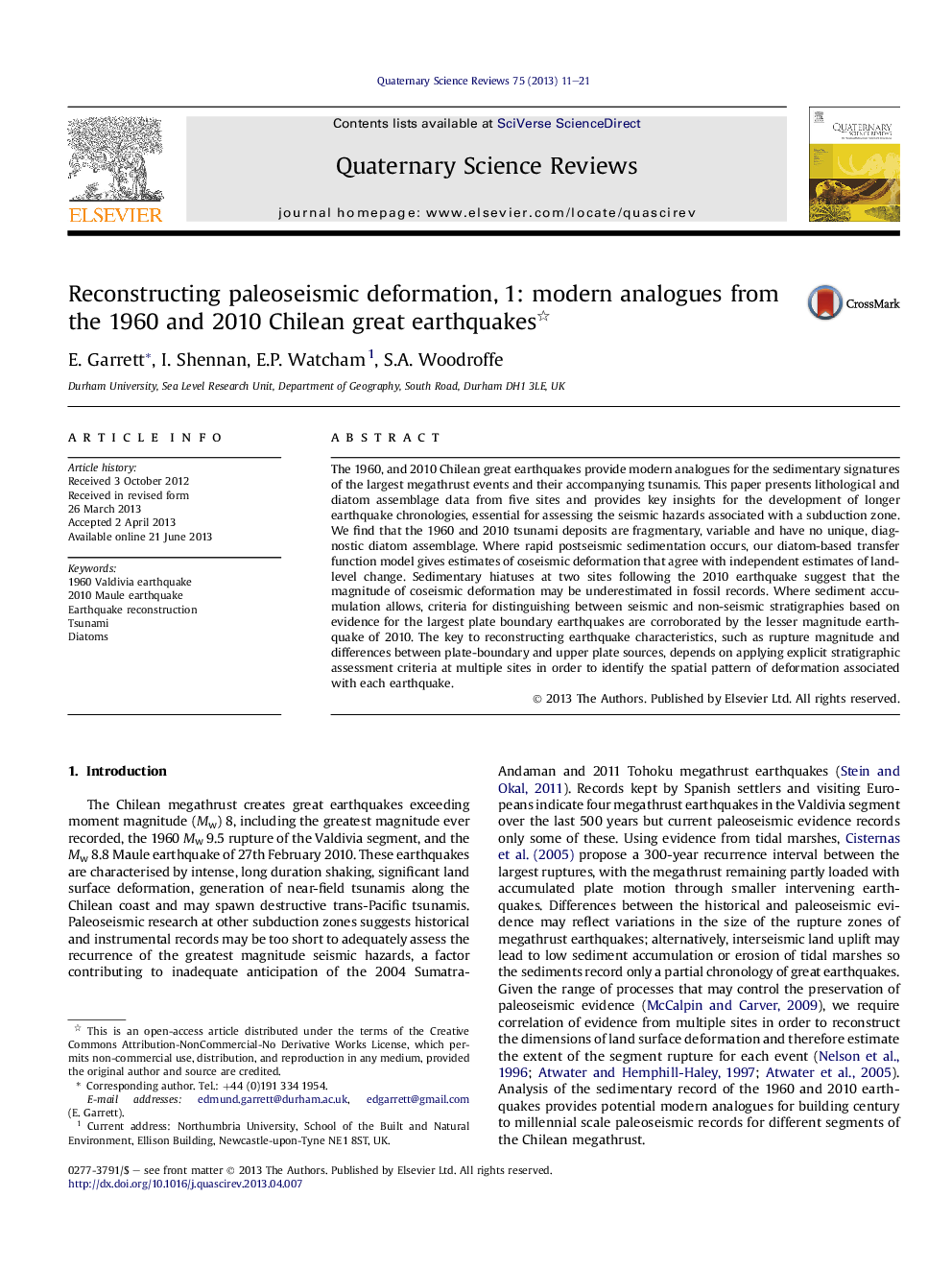| کد مقاله | کد نشریه | سال انتشار | مقاله انگلیسی | نسخه تمام متن |
|---|---|---|---|---|
| 6446708 | 1640859 | 2013 | 11 صفحه PDF | دانلود رایگان |
عنوان انگلیسی مقاله ISI
Reconstructing paleoseismic deformation, 1: modern analogues from the 1960 and 2010 Chilean great earthquakes
ترجمه فارسی عنوان
بازسازی تغییر شکل پائئوسئیسم، 1: آنالوگ مدرن از زمین لرزه های بزرگ سال 1960 و 2010 شیلی
دانلود مقاله + سفارش ترجمه
دانلود مقاله ISI انگلیسی
رایگان برای ایرانیان
کلمات کلیدی
ترجمه چکیده
زمین لرزه های بزرگ شیلی در سال های 1960 و 2010، معادلات مدرن را برای امضاهای رسوبی بزرگترین رویدادهای مگاتراست و سونامی های همراه آنها ارائه می دهند. این مقاله اطلاعات مربوط به سنگ شناسی و دیاومی را از پنج سایت ارائه می دهد و بینش های کلیدی برای توسعه زلزله های زلزله طولانی را که ضروری است برای ارزیابی خطرات لرزه ای مرتبط با ناحیه فرونشانی فراهم می کند. متوجه می شویم که ذخایر سونامی 1960 و 2010 تقسیم بندی، متغیر هستند و هیچ مجموعه ای از تشخیص قطعی ندارند. در جایی که سریع رسوب رسوبات رخ می دهد، مدل تابع انتقال مبتنی بر دیاتوم ما برآورد های تغییر شکل مخلوطی را که با برآوردهای مستقل تغییر سطح زمین مطابقت دارد، ارائه می دهد. تعطیلی رسوبی در دو سایت پس از زلزله سال 2010 نشان می دهد که مقدار تغییر شکل مخروطی ممکن است در پرونده های فسیلی کم اهمیت باشد. از آنجا که انباشت رسوب اجازه می دهد، معیارهای تمایز بین چینه شناسی های لرزه ای و غیر لرزه ای براساس شواهد برای بزرگترین زلزله های مرز بشقاب، توسط زمین لرزه ای کمتر از سال 2010 تأیید می شود. کلید بازسازی ویژگی های زلزله، مانند اندازه گیری پارگی و تفاوت بین صفحات - منابع مرزی و بالای صفحه، بستگی به اعمال معیارهای ارزیابی استراتژیک صریح در چندین سایت برای شناسایی الگوی فضایی تغییر شکل در ارتباط با هر زلزله دارد.
موضوعات مرتبط
مهندسی و علوم پایه
علوم زمین و سیارات
زمین شناسی
چکیده انگلیسی
The 1960, and 2010 Chilean great earthquakes provide modern analogues for the sedimentary signatures of the largest megathrust events and their accompanying tsunamis. This paper presents lithological and diatom assemblage data from five sites and provides key insights for the development of longer earthquake chronologies, essential for assessing the seismic hazards associated with a subduction zone. We find that the 1960 and 2010 tsunami deposits are fragmentary, variable and have no unique, diagnostic diatom assemblage. Where rapid postseismic sedimentation occurs, our diatom-based transfer function model gives estimates of coseismic deformation that agree with independent estimates of land-level change. Sedimentary hiatuses at two sites following the 2010 earthquake suggest that the magnitude of coseismic deformation may be underestimated in fossil records. Where sediment accumulation allows, criteria for distinguishing between seismic and non-seismic stratigraphies based on evidence for the largest plate boundary earthquakes are corroborated by the lesser magnitude earthquake of 2010. The key to reconstructing earthquake characteristics, such as rupture magnitude and differences between plate-boundary and upper plate sources, depends on applying explicit stratigraphic assessment criteria at multiple sites in order to identify the spatial pattern of deformation associated with each earthquake.
ناشر
Database: Elsevier - ScienceDirect (ساینس دایرکت)
Journal: Quaternary Science Reviews - Volume 75, 1 September 2013, Pages 11-21
Journal: Quaternary Science Reviews - Volume 75, 1 September 2013, Pages 11-21
نویسندگان
E. Garrett, I. Shennan, E.P. Watcham, S.A. Woodroffe,
